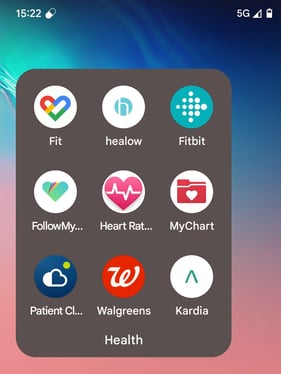
Welcome to the world of digital therapeutics.
Most of us have at least a couple of healthcare-related apps on our phones: patient portals, fitness trackers, wearable monitors, and even pharmacy apps. Many of the ubiquitous health apps available today are focused on awareness . Awareness of your vital signs, awareness of your body’s cycles and limits, awareness of your lab results and medical records, and awareness of your traditional prescription refill availability.

When you think about digital health, picture a three-legged stool with awareness being one of the three legs. Patient awareness is a key component of health. You can’t address what you don’t know about! Apps commonly help with surveillance, risk screening, and medication or treatment adherence. A patient who is more educated about their own body and treatments can take greater ownership of their care and outcomes.
But awareness-focused health apps aren’t considered new or innovative in the 2020’s, and they typically aren’t regulated by the FDA as digital therapeutics, although they may occasionally be regulated as medical devices.
Beyond Health Awareness: Education
So if awareness is the first leg of our three-legged digital health stool, what are the other two legs? Education and adaptation. Education goes beyond awareness and brings patients closer to action. Digital health-related awareness apps are often recommended by a medical provider, but can’t technically be prescribed. They are typically either free in the app store or available for a small fee.
In this category we include the many medical device training apps published by pharma and medical device companies, including this app that we designed and built for Merck and localized to 16 countries and counting.
Education related digital health apps focused on addiction often focus on helping patients understand the common factors leading to addiction, the cost and consequences of addiction, and the resources available on the road to recovery.
Hygiene, nutrition, menstrual cycles and fertility, pregnancy, child development, and medication risks and interactions apps also commonly fall under the digital health education umbrella.
The Third Leg: Adaptation via DTx
Adaptation is our third leg on the digital health stool. Apps falling into this category are the ones most commonly regulated as true digital therapeutics (commonly shortened to DTx). We use the term adaptation here because in most cases, digital therapeutics aren’t aiming to completely cure an ailment or disorder. They are instead focused on modifying a particular habit, mindset, or behavior that is a symptom or outcome of an ailment or disorder or that can reduce the impact of an ailment or disorder.
In this way they can be considered similar to pain relievers or fever reducers. They aren’t going to cure the infection or injury, but they can make it more manageable while other treatments or your body’s traditional defenses make progress on the primary cause.
Digital therapeutics are essentially apps that can be prescribed to patients as a treatment. Those approved by the FDA so far include a VR app for chronic pain reduction , a mobile app for addiction recovery , and a gamified app aimed at improving attention function in neurodivergent children.
Imagine receiving a new diagnosis at your medical provider’s office and leaving with not only a prescription for a traditional pharmaceutical medication, but also a prescription to download and use an app. This type of combo-treatment approach has been commonly taken with many conditions historically but instead of an app, you may have been prescribed regular physical, behavioral or group therapy. Digital therapeutics are just another tool in your provider’s toolbelt, giving a broader range of options to meet a broader range of patient’s needs.
So how well do these apps work? Take a look at EndeavorRx, an FDA-approved gamified treatment app designed to treat ADHD in children aged 8-12. It makes use of sensory stimulation and incremental challenges to help kids advance multitasking skills and retain focus. Participant surveys report 73% of children noticed they could pay attention better after 1 month of treatment, while 68% of parents noted signs of improvement after 2 months of treatment. No adverse effects were reported, signifying ADHD apps can be both effective and safe to use.
Here at Part Time Evil we haven’t submitted any apps for FDA approval (yet), but we’ve worked on multiple VR and mobile apps that are being utilized for grant-funded research and in clinical trials, including this VR mindfulness training app we developed for VCU Health and this Smoking Cessation aid for Health Behavior Solutions. We’re currently working on multiple additional products that will be entering the clinical trial phase in the next year.
Digital therapeutic apps increase accessibility and effectiveness while potentially lowering the long term cost of treatment. It’s an exciting new area of health innovation that we’re proud to be a part of. Get in touch with us if you have any questions about treatment apps or already have a project in mind. If you want to stay up-to-date, follow along as we develop new and exciting apps in the field of digital healthcare.



